


Emily Dickinson - The Game 58
 Chris Hocking went first, and presented a unique approach that would have allowed DS players to actually recreate Emily Dickinson's works by taking on the role of her Muse. His design used a formal language structure which would have distilled down her works into their component parts. These parts, then, would have been strung together into a cohesive whole to actually "write" the poem. The concepts were to have been "mined" from the real world as Emily moved about her daily business, with the player's task being to manipulate her just enough to get what they needed for the poem.
Chris Hocking went first, and presented a unique approach that would have allowed DS players to actually recreate Emily Dickinson's works by taking on the role of her Muse. His design used a formal language structure which would have distilled down her works into their component parts. These parts, then, would have been strung together into a cohesive whole to actually "write" the poem. The concepts were to have been "mined" from the real world as Emily moved about her daily business, with the player's task being to manipulate her just enough to get what they needed for the poem.
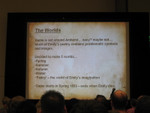 His example was that of an old willow tree, which could have been a point to collect several different concepts such as beauty or strength. Once you had all the necessary components, you'd write them together to complete the poem. As a reward, you'd be treated to a music and video reading of the work you'd completed. He specifically wanted the game to be somewhat open ended, so that the possibility of a sequel could be kept in mind. He also included some rudimentary plans for wireless integration by allowing players to send each other concepts, or to allow a look ahead by viewing another player's completed poem.
His example was that of an old willow tree, which could have been a point to collect several different concepts such as beauty or strength. Once you had all the necessary components, you'd write them together to complete the poem. As a reward, you'd be treated to a music and video reading of the work you'd completed. He specifically wanted the game to be somewhat open ended, so that the possibility of a sequel could be kept in mind. He also included some rudimentary plans for wireless integration by allowing players to send each other concepts, or to allow a look ahead by viewing another player's completed poem.
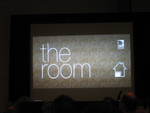 Peter Molyneux got up on stage and said "So, I went a bit overboard." He'd come prepared with an actual demo of a game, entitled "The Room". While it wasn't the crowd's favorite design it was definitely impressive. If you'd like to see part of the demo, I have some video
available, but in a nutshell the game involves using "virtual clay" to form objects inside spaces based on Dickinson's poems. Once you'd managed to make an object or alter the area to recreate the environment in which she'd written the poem, a line of the poem was read and you could move on to another object. Molyneux stated that he is dyslexic, and not very familiar with poetry, so he wanted to give a hands on feel to what could have otherwise been a pie in the sky idea.
Peter Molyneux got up on stage and said "So, I went a bit overboard." He'd come prepared with an actual demo of a game, entitled "The Room". While it wasn't the crowd's favorite design it was definitely impressive. If you'd like to see part of the demo, I have some video
available, but in a nutshell the game involves using "virtual clay" to form objects inside spaces based on Dickinson's poems. Once you'd managed to make an object or alter the area to recreate the environment in which she'd written the poem, a line of the poem was read and you could move on to another object. Molyneux stated that he is dyslexic, and not very familiar with poetry, so he wanted to give a hands on feel to what could have otherwise been a pie in the sky idea.
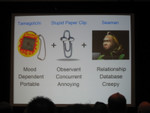
Then he put forth his goals. He wanted to have the mood dependency and portability of a Tamagotchi, the helpful/annoyance of Clippy, and the relationship and creepy aspects of seaman.
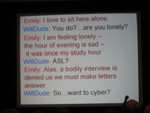 These interactions would include Instant Messaging, email, and interruptions while writing. Over time, the program would develop a model of behavior depending on how you'd interacted with it. Will's thought was that, while you could eventually get her to a stable state it was more likely that she'd become romantically obsessed with you, or suicidally depressive. In the latter case, he said, she would have the option of deleting herself off the USB drive.
These interactions would include Instant Messaging, email, and interruptions while writing. Over time, the program would develop a model of behavior depending on how you'd interacted with it. Will's thought was that, while you could eventually get her to a stable state it was more likely that she'd become romantically obsessed with you, or suicidally depressive. In the latter case, he said, she would have the option of deleting herself off the USB drive.
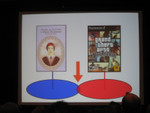

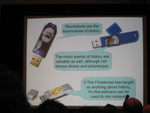
He won? (Score:5, Insightful)
Re:He won? (Score:1)
The AI would have to be tweaked and would need to recognize the other cartridge in order for it to work well but I am sure that would only take some minor programming.
Like making an intellegentsia totally thumb their nose at a buffon yet chat profusely with another genius.
Re:He won? (Score:1)
Re:He won? (Score:2)
Wright's design was innovative, and sounded quite promising-- it could be fun given some tweaking. Hocking's and Molyneux's were both very interesting directions to take, but they ultimately dead-ended. Hocking's would have remained tedious, and the thr
Re:He won? (Score:2)
Molyneux's idea sounds cool at first, but limits itself to only falling into the realm of edutainment, and is sorely lacking in the "tainment" part. It's not really a "game" anymore when all you're trying to do is make an object out of virtual clay so it spits another line of text/speech at you. It's basically the same as the old text adventures back in the day with "get yon flask", with a new interface that meets the new level of annoyance of today's level of gamer.
While
Scenarios? (Score:3, Interesting)
Re:Scenarios? (Score:3, Informative)
When I played the game back in the '80s I found it really unique. It was interesting to uncover the story elements by going through the databases.
Another game
Re:Scenarios? (Score:2)
I think you're wrong about these getting produced now though. Remember the graphic showing the overlap between Dickenson and GTA? I bet thats roughly the same diagram as for The Sims, and that would be the perfect environment for such a thing. Famous Poets expansion pack, anyone? Hell, I'd buy SimEin
Re:Scenarios? (Score:1)
I've often wished for something more realistic - more intelligent, more
Re:Scenarios? (Score:2)
Re:Scenarios? (Score:1)
Re:Scenarios? (Score:2)
Re:Scenarios? (Score:1)
Re:I'd rather play Halo. (Score:2, Insightful)
Re:I'd rather play Halo. (Score:2)
I think the only really innovative game I've played recently is Katamari Damacy. And they released it here as a low cost title, I guess because they didn't think any Americans would want to play something so unusual. Hell, even the end credits were great!
Re:I'd rather play Halo. (Score:1)
Katamari isn't alone. There are tons of great games that just don't get published in certain territories, or indeed at all.
And don't start me on the amazing games that get bought-up then promptly shelved by certain publishers so that they do not compete with their "AAA" titles.
Re:I'd rather play Halo. (Score:1)
It might have been more popular if either of the words "katmari" or "damacy" actually meant anything.
Re:I'd rather play Halo. (Score:2)
I'm personally glad they kept the original Japanese title (Katamari Damashii = Clump of Souls) instead of Americanizing it.
Re:I'd rather play Halo. (Score:2)
I don't think there is a good American name for it - to be frank the game SOUNDS really stupid when you read about it. About the only thing they could have called it that would make any sense would be like "Roll Up".
Maybe they should have just shortened it to Katamari.
Then again "Metal Gear Solid Katamari World Eater" might have garnered more attention.
Re:I'd rather play Halo. (Score:2)
Absolutely. Just the same as in any other media, video games aren't any different. It's the same reason why we get crap churned out of Hollywood and have to look for the gems.
And just like Hollywood, so many of these games are produced very professionally with technically excellent design, but many of them lack (um for lack of a better term) soul. They just don't feel like anyone had fun MAKING the game or really
The Room - What Engine? (Score:2)
Re:The Room - What Engine? (Score:2)
Zero Effect (Score:3, Insightful)
Re:Zero Effect (Score:2)
In any case: goooooooo Wright!
Re:Zero Effect (Score:2)
Re:Zero Effect (Score:2)
I'm confident that once the public finds out they can have their very own Emily Dickenson electronic virtual pet on their keychain, and have it connect to other literary virtual pets, that the legenary American drive for consumption will cause everyone to run out and buy ten each.
Er... we
Re:Zero Effect (Score:1, Funny)
No-install games on CD? It'll never work. Next you'll be telling me that this magic machine of yours can also connect to a big TV instead of a monitor, or that you can control it with some sort of special "game pad" instead of a good old keyboard. That's just crazy.
Re: (Score:2, Interesting)
Re:Whoa! (Score:2)
When They open the chest there is a minature room, which they enter. Then that room is connected to the room that had the chest, which has the minature room they were now in.
The left the minature room and re-entered the original room (now minature too?) that had a chest with another minature (minature) room.
It sounds merely like a gamespace realization of a usage-produced hypertext system, such as used with the softlinks over at Everything [everything2.com].
Well I say "
Emily Dickinson game (Score:5, Funny)
Re:Emily Dickinson game (Score:1)
Can you tell where I went to high school? *ducks*
Re:Emily Dickinson game (Score:2)
Re:Emily Dickinson game (Score:3, Informative)
Wait, we already have this (Score:2)
All you have to do is open up emacs and start up psychoanalyze-pinhead and poof, there you go. Eliza meets Zippy the Pinhead!
(For more information, go here [ibm.com] and scroll down a little.)
Next Year (We Promise) (Score:2, Funny)
Sorry.
So, how does she cyber? (Score:3, Funny)
Re:So, how does she cyber? (Score:2)
digital clay (Score:3, Interesting)
Easy (Score:1)
Chris Hocking for the Win! (Score:3, Insightful)
I respect Mr. Molyneux's vision a lot, but from other session writeups I've seen it seems like he made the demo to kill more than just the Emily Dickinson bird. Slapping the Dickinson license into your tech demo is cool and all, but not really in my idea of the challenge's spirit.
Will Wright, I think, half came up with USB Emily just to goof around. Even his goofing around (obviously) is good work, but he seemed almost embarrased to recieve the prize for the competition.
Re:Chris Hocking for the Win! (Score:3, Funny)
Will's idea: "Eliza bot cum Sims! The first one will more than likely be boring but we'll make a killing on selling the expansion packs!"
Peter's idea: "I have an idea that really has nothing to do with Emily Dickenson! I'll market it as the best Emily Dickenson game out there but the only thing you'll learn about her from playing my game is that appearently she liked clay alot! Of cours
Re:Chris Hocking for the Win! (Score:2)
That's American McGee you're talking about.